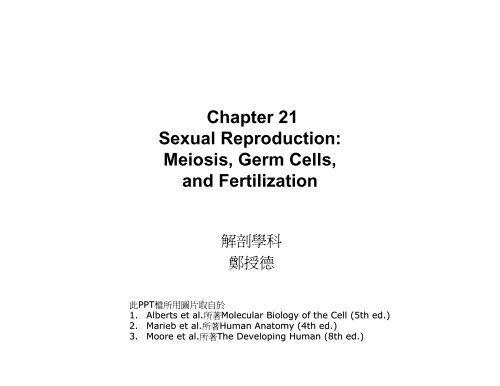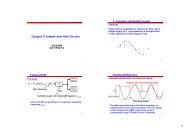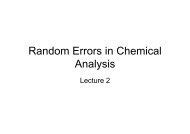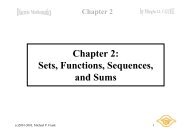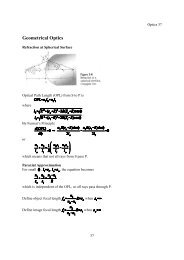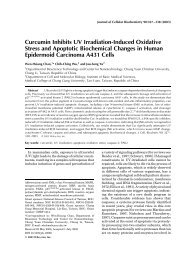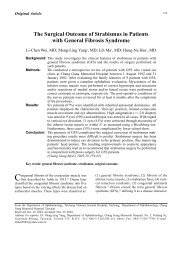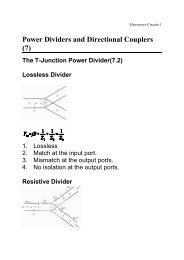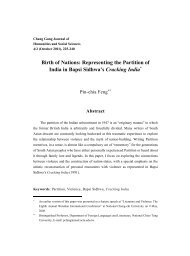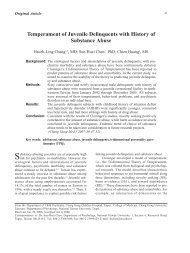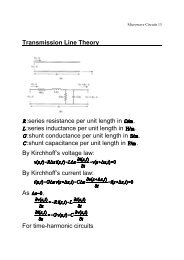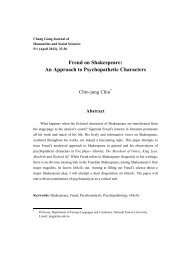Meiosis, Germ Cells, and Fertilization
Meiosis, Germ Cells, and Fertilization
Meiosis, Germ Cells, and Fertilization
Create successful ePaper yourself
Turn your PDF publications into a flip-book with our unique Google optimized e-Paper software.
Chapter 21<br />
Sexual Reproduction:<br />
<strong>Meiosis</strong>, <strong>Germ</strong> <strong>Cells</strong>,<br />
<strong>and</strong> <strong>Fertilization</strong><br />
解 剖 學 科<br />
鄭 授 德<br />
此 PPT 檔 所 用 圖 片 取 自 於<br />
1. Alberts et al. 所 著 Molecular Biology of the Cell (5th ed.)<br />
2. Marieb et al. 所 著 Human Anatomy (4th ed.)<br />
3. Moore et al. 所 著 The Developing Human (8th ed.)
• Asexual reproduction<br />
– plants propagate vegetatively<br />
– Hydra can produce offspring by budding<br />
– offspring that are genetically identical to their parent<br />
• Sexual reproduction<br />
– mixes the genomes from two individuals
OVERVIEW OF SEXUAL REPRODUCTION<br />
• Diploid<br />
– each cell contains two sets of chromosomes,<br />
– one inherited from each parent<br />
• Haploid<br />
– each cell contains only one set of chromosomes<br />
– mixing the two genomes <strong>and</strong> restoring the diploid
<strong>Meiosis</strong><br />
– a diploid precursor cell gives rise to haploid progeny cells<br />
• haploid cells<br />
– produced by meiosis<br />
– develop into highly specialized gametes-eggs (or ova), sperm<br />
(or spermatozoa), pollen, or spores
<strong>Fertilization</strong><br />
• a haploid sperm fuses with a haploid<br />
egg to form a diploid cell (a fertilized<br />
egg, or zygote)<br />
• a new combination of chromosomes<br />
• the process of fertilization, in which an<br />
egg <strong>and</strong> a sperm fuse to form a new<br />
diploid organism
The Haploid Phase in Higher Eucaryotes<br />
Is Brief<br />
• diploid cells proliferate by mitotic cell division<br />
• haploid cells that form by meiosis do not<br />
proliferate<br />
• For all vertebrates<br />
– only the diploid cells proliferate<br />
– the haploid gametes exist only briefly for sexual<br />
fusion
• germ line (or germ cells)<br />
– include gametes <strong>and</strong> their specified diploid precursor cells<br />
• somatic cells<br />
– which form the rest of the body <strong>and</strong> ultimately leave no progeny
<strong>Meiosis</strong> Creates Genetic Diversity<br />
• Autosomes<br />
– common to all members of the species<br />
• Sex chromosomes<br />
– differently distributed according to the sex of the individual<br />
• homologous chromosomes, or homologs<br />
– two copies of each autosome, one from the mother <strong>and</strong> one from the<br />
father<br />
– physically pairing <strong>and</strong> undergoing genetic recombination
Crossing-over<br />
• the maternal <strong>and</strong> paternal versions of each chromosome have similar DNA<br />
sequences<br />
• they are not identical, <strong>and</strong> they undergo genetic recombination during<br />
meiosis<br />
• produce novel hybrid versions of each chromosome<br />
• each chromosome in a gamete contains a unique mixture of genetic<br />
information from both parents
Sexual Reproduction Gives Organisms a<br />
Competitive Advantage<br />
• resources spent on the machinery of sexual<br />
reproduction are large.<br />
• One advantage of sexual reproduction<br />
seems to be that the reshuffling of genes<br />
helps a species to survive in an<br />
unpredictably variable environment.<br />
• Another advantage of sexual reproduction<br />
seems to be that it can help eliminate<br />
deleterious genes from a population
MEIOSIS<br />
• haploid germ cells arise from a special kind of cell<br />
division in which the number of chromosomes is<br />
precisely halved<br />
• S phase is omitted; a single cell division produces two<br />
haploid cells directly<br />
• accurate chromosome segregation during meiosis
Gametes Are Produced by Two Meiotic<br />
Cell Divisions<br />
• the chromosomes have replicated their DNA (in meiotic S phase)<br />
• two copies are tightly bound together by cohesin complexes <br />
Sister chromatids<br />
• a single round of DNA replication is followed by two successive<br />
rounds of chromosome segregation
Duplicated Homologs (<strong>and</strong> Sex Chromosomes)<br />
Pair During Early Prophase I<br />
• Special mechanisms mediate these<br />
intimate interactions between homologs<br />
• Prolonged meiotic prophase (prophase I)<br />
• sister chromatids tightly glued together<br />
called pairing<br />
• forming a four-chromatid structure called<br />
a bivalent<br />
• breaks in chromatid double-str<strong>and</strong> DNA<br />
• a fragment of a maternal chromatid is<br />
exchanged for a corresponding fragment<br />
of a homologous paternal chromatid
• The ends of the chromosomes (the telomeres) are tightly<br />
bound to the inner surface of the nuclear envelope.<br />
• prevent chromosome entanglements<br />
• later still, disperse again
Pairing between sex chromosomes<br />
• A small region of homology between the X <strong>and</strong> the Y at one or both ends<br />
• only two types of sperm are normally produced<br />
• Sperms those containing one Y chromosome will give rise to male embryos<br />
• those containing one X chromosome will give rise to female embryos
Homolog Pairing Culminates in the<br />
Formation of a Synaptonemal Complex<br />
• The axial cores are about 400 nm apart<br />
• Programmed double-str<strong>and</strong> DNA breaks<br />
• Recombination complex assembles on a double-str<strong>and</strong> break<br />
• Presynaptic alignment of the homologs<br />
• During synapsis, the transverse filaments link the axial cores of a homolog<br />
pair as a synaptonemal complex, that bridges the gap of only 100 nm.
During dividing prophase I<br />
• Leptotene<br />
– homologs condense <strong>and</strong> pair, <strong>and</strong> genetic recombination begins<br />
• Zygotene<br />
– synaptonemal complex begins to assemble in local regions along the<br />
homologs<br />
• Pachytene<br />
– the homologs are synapsed along their entire lengths<br />
• Diplotene<br />
– disassembly of the synaptonemal complexes<br />
– concomitant condensation, shortening of chromosomes.
• Chiasmata (chiasma)<br />
– individual crossover events between nonsister chromatids<br />
• Diakinesis<br />
– the process of segregation<br />
– Prophase I ends; transition to metaphase I<br />
• proteins are important for crossing-over<br />
• Cohesin complexes<br />
– major components of the axial core of each homolog<br />
– play crucial parts in segregating
Homolog Segregation Depends on <strong>Meiosis</strong>-<br />
Specific, Kinetochore-Associated Proteins<br />
• Kinetochores<br />
– protein complexes associated with the centromeres<br />
• Kinetochores on the two sister chromatids attach to opposite poles of the<br />
spindle<br />
• Segregate into different daughter cells at anaphase<br />
• Arms of the sister chromatids of homologs separate at anaphase I
• Sisters stay glued together in the region of their centromeres until anaphase<br />
II<br />
• Shugoshins associated with kinetochores help ensure that sister<br />
kinetochores do not come apart at anaphase I<br />
• Proteolytic enzyme separase cleaves the cohesin complexes
• <strong>Meiosis</strong> II occurs without DNA replication.<br />
• Prophase II is brief<br />
• Metaphase II, anaphase II, <strong>and</strong> telophase II are in quick succession.<br />
• Four haploid nuclei produced<br />
• cytokinesis occurs<br />
• <strong>Meiosis</strong> is complete.
<strong>Meiosis</strong> Frequently Goes Wrong<br />
• female meiosis, which arrests for years after diplotene<br />
• meiosis I is completed only at ovulation<br />
• meiosis II only after the egg is fertilized.<br />
• such chromosome segregation errors during egg development are the<br />
commonest cause of both spontaneous abortion (miscarriage) <strong>and</strong> mental<br />
retardation in humans.<br />
• Nondisjunction<br />
– the result is that some of the haploid gametes produced lack a particular<br />
chromosome, while others have more than one copy of it.<br />
• Aneuploid<br />
– <strong>Cells</strong> with an abnormal number of chromosomes<br />
• Down syndrome<br />
– an extra copy of chromosome 21<br />
• Segregation errors during meiosis I increase greatly with advancing<br />
maternal age.
Normal<br />
Gametogenesis
Nondisjunction<br />
Homologs fail to<br />
separate; about 10% in<br />
human oocytes,<br />
inducing miscarriages or<br />
Down's syndrome
Nondisjunction
Genetic Reassortment<br />
• R<strong>and</strong>om distribution of maternal <strong>and</strong><br />
paternal homologs produce 2 n genetically<br />
different gametes.<br />
• 2 23 = 8.4 × 10 6
Crossing-Over Enhances Genetic Reassortment<br />
• Chromosomal crossing-over<br />
– DNA segments of homologous<br />
chromosomes are exchanged<br />
• On average, between two <strong>and</strong> three<br />
crossovers occur between each pair of<br />
human homologs.
Crossing-Over Is Highly Regulated<br />
• hold homologs together; properly segregated<br />
• double-str<strong>and</strong> breaks at “hot spots”<br />
• Crossovers operate before the synaptonemal complex assembles.<br />
• at least one crossover forms between the members of each homolog pair.<br />
• Crossover interference<br />
– presence of one crossover event inhibits another from forming close by
<strong>Meiosis</strong> Is Regulated Differently in<br />
Male <strong>and</strong> Female Mammals<br />
• <strong>Meiosis</strong> in a human male lasts for 24 days, compared<br />
with 12 days in the mouse.<br />
• In human females, it can last 40 years or more, because<br />
meiosis I arrests after diplotene.<br />
• Most of meiosis is spent in prophase I<br />
• Egg precursor cells (oocytes) begin meiosis in the fetal<br />
ovary but arrest after diplotene, after the synaptonemal<br />
complex has disassembled in meiosis I.<br />
• complete meiosis I<br />
– only after the female has become sexually mature<br />
– the oocyte is released from the ovary during ovulation<br />
• completes meiosis II<br />
– only if it is fertilized.
• It takes about 24 days for a human spermatocyte to<br />
complete meiosis.<br />
• About 20% of human eggs are aneuploid, compared with 3–<br />
4% of human sperm<br />
• Cell-cycle checkpoint mechanism arrests meiosis <strong>and</strong> leads<br />
to cell death by apoptosis.<br />
• The average number of new mutations contributed by<br />
fathers is larger than the number contributed by mothers.<br />
• by the end of meiosis, a mammalian egg is fully mature,<br />
whereas a sperm that has completed meiosis has only just<br />
begun its differentiation.
PRIMORDIAL GERM CELLS AND SEX<br />
DETERMINATION IN MAMMAL<br />
• Diploid primordial germ cells (PGCs) migrate to the<br />
developing gonads, which will form the ovaries in<br />
females <strong>and</strong> the testes in males.<br />
• Mitotic proliferation in the developing gonads<br />
• PGCs undergo meiosis <strong>and</strong> differentiate into mature<br />
haploid gametes - either eggs or sperm.
Signals from Neighbors Specify PGCs in<br />
Mammalian Embryos<br />
• germ cell determinants become PGCs<br />
• antibody that labels (in green) small granules (called P<br />
granules) that function as germ cell determinants.
• Totipotent – the potential to give rise to any of the cell types of the animal,<br />
including the germ cells<br />
• turning off the expression of a number of somatic cell genes <strong>and</strong> turning on<br />
the expression of genes involved in maintaining the special character of the<br />
germ cells.
Migration of mammalian PGCs<br />
• secreted signal proteins that help attract PGCs into the<br />
developing gonad at genital ridge are chemokines<br />
• embryonic germ (EG) cells resemble embryonic stem<br />
(ES) cells<br />
• The sex chromosomes in the somatic cells of the<br />
genital ridge determine which type of gonad the ridge<br />
becomes.<br />
• a single gene on the Y chromosome has an especially<br />
important role.
Male<br />
Female
The Sry Gene Directs the Developing<br />
Mammalian Gonad to Become a Testis<br />
• In egg-laying reptiles, the temperature of the incubating egg determines the<br />
sex of the offspring<br />
• The presence or absence of the Y chromosome determines the sex of the<br />
individual.<br />
• The Y chromosome directs the somatic cells of the genital ridge to develop<br />
into a testis.<br />
• the secreted signal protein Wnt4, for example, is required for normal<br />
mammalian ovary development.<br />
• The crucial gene on the Y chromosome is called Sry (sex-determining<br />
region of Y).<br />
• Sex-reversed mice cannot produce sperm, because they lack genes for<br />
sperm development.<br />
• Sry gene is introduced into the genome of an XX mouse zygote, the<br />
transgenic embryo produced develops as a male.<br />
• Sertoli cells are the main type of supporting cells in the testis.
Four ways Sertoli cells influencing other cells<br />
1. stimulate the PGCs entering<br />
meiosis <strong>and</strong> produce sperm.<br />
2. secrete anti-Müllerian hormone<br />
causing the Müllerian duct to<br />
regress<br />
3. stimulate endothelial <strong>and</strong> smooth<br />
muscle cells migrate into the<br />
developing gonad<br />
4. induce other somatic cells to<br />
become Leydig cells, which secrete<br />
the male sex hormone testosterone<br />
for developing Wolffian duct system,<br />
<strong>and</strong> male sexual identity
• Sry normally acts by inducing the<br />
expression of Sox9.<br />
• The Sox9 protein directly activates the<br />
gene encoding anti-Müllerian hormone.<br />
• In the absence of either Sry or Sox9, the<br />
genital ridge of an XY embryo develops<br />
into an ovary instead of a testis.<br />
• The supporting cells become follicle cells<br />
instead of Sertoli cells.<br />
• Other somatic cells become theca cells<br />
(instead of Leydig cells),<br />
• PGCs develop along a pathway that<br />
produces eggs rather than sperm.
• molecule retinoic acid produced by mesonephros adjacent to the developing<br />
gonad induces the proliferating germ-line cells to enter meiosis.<br />
• arrested after diplotene of prophase I, but still ovulate<br />
• Sertoli cells produce an enzyme that degrades retinoic acid, <strong>and</strong> prevent the<br />
germ-line cells to enter meiosis.<br />
• Much later to begin producing sperm.
Many Aspects of Sexual Reproduction<br />
Vary Greatly between Animal Species<br />
• C. elegans <strong>and</strong> Drosophila<br />
– by the ratio of X chromosomes to autosomes<br />
• C. elegans<br />
– transcriptional <strong>and</strong> translational controls on gene expression<br />
• Drosophila<br />
– on a cascade of regulated RNA splicing events,
EGGS<br />
• once activated, it can give rise to a complete new individual<br />
• Activation is usually the consequence of fertilization (fusion of a sperm with<br />
the egg).<br />
• Some lizards’ eggs become activated in the absence of sperm<br />
(parthenogenetically).<br />
• Mammals cannot; because of genomic imprinting (they require both<br />
maternal <strong>and</strong> paternal genetic contributions).<br />
• The cytoplasm of an egg can even reprogram a somatic cell nucleus so that<br />
the nucleus can direct the development of a new individual.<br />
• Reproductive cloning has been used to produce clones of various mammals.<br />
• Less than 5% of them develop to adulthood
An Egg Is Highly Specialized for<br />
Independent Development<br />
• Egg<br />
– giant single cell<br />
– cleaves into many smaller cells<br />
– diameter of about 0.1 mm in humans <strong>and</strong> sea urchins<br />
– 1–2 mm in frogs <strong>and</strong> fishes<br />
– many centimeters in birds <strong>and</strong> reptiles<br />
• A somatic cell has a diameter of only about 10–30<br />
micrometer
• Yolk<br />
– rich in lipids, proteins, <strong>and</strong> polysaccharides <strong>and</strong> yolk granules.<br />
• Egg coat<br />
– Extracellular matrix consisting largely of glycoproteins<br />
– Vitelline layer in eggs of sea urchins or chickens<br />
– Zona pellucida in mammalian eggs<br />
– acts as a species-specific barrier to sperm
• Cortical granules<br />
– specialized secretory vesicles in cortex of the egg cytoplasm.<br />
– exocytosis the contents of the granules alter the egg coat<br />
– so as to help prevent more than one sperm from fusing with the egg.<br />
• Some egg cytoplasmic components have a strikingly asymmetrical<br />
distribution to help establish the polarity of the embryo
Oogenesis<br />
Eggs Develop in Stages<br />
• differentiates into a mature egg (or ovum)<br />
• Primordial germ cells migrate to the forming gonad to become oogonia<br />
• proliferate by mitosis for a period before beginning meiosis I, at which point<br />
they are called primary oocytes.<br />
• oocytes arrest for a prolonged period in meiosis I<br />
• after completing meiosis I, they arrest again in metaphase II while awaiting<br />
fertilization
• before birth in mammals.<br />
• prior to the onset of meiosis I, the DNA replicates<br />
• start of prophase I crossing-over occurs between nonsister chromatids<br />
• arrested after diplotene of prophase I<br />
• primary oocytes synthesize a coat <strong>and</strong> cortical granules.<br />
• intensive biosynthetic activities<br />
• progress through meiosis I.<br />
• replicated homologous chromosomes segregate at anaphase I<br />
• a small polar body <strong>and</strong> a large secondary oocyte
• each chromosome is still composed of two sister chromatids held together<br />
at their centromeres.<br />
• At ovulation, the arrested secondary oocyte is released from the ovary,<br />
ready to be fertilized.<br />
• fertilization occurs, the cell completes meiosis, becoming a mature egg.<br />
• anaphase II, the large secondary oocyte divides to produce the mature egg<br />
(or ovum) <strong>and</strong> a second polar body<br />
• Because it is fertilized, it is also called a zygote.
Oocytes Use Special Mechanisms to<br />
Grow to Their Large Size
Extra gene copies in the cell<br />
• diploid chromosome set for RNA synthesis with 100 to<br />
500 copies of the ribosomal RNA genes<br />
• increased rate of protein synthesis<br />
From neighboring accessory cells<br />
• Yolk imported into the oocyte<br />
• In some invertebrates a common oogonium gives rise to<br />
one oocyte <strong>and</strong> 15 nurse cells<br />
• follicle cells surround each developing oocyte<br />
• gap-junction proteins (connexins) involved in connecting<br />
follicle cells to each other are different from those<br />
connecting follicle cells to the oocyte.
Most Human Oocytes Die Without Maturing<br />
• A single layer of follicle cells surrounds most of the primary oocytes in<br />
newborn girls.<br />
• Such an oocyte, together with its surrounding follicle cells, is called a<br />
primordial follicle<br />
• a small proportion of primordial follicles begin to grow to become developing<br />
follicles, in which multiple layers of follicle cells (now called granulosa cells)<br />
• Some of these developing follicles go on to acquire a fluid-filled cavity, or<br />
antrum, to become antral follicles.
• Follicle stimulating hormone (FSH) accelerates the growth of about 10–12<br />
antral follicles<br />
• Luteinizing hormone (LH) triggers ovulation<br />
• the dominant primary oocyte completes meiosis I<br />
• the resulting secondary oocyte arrests at metaphase II
Premordial follicle <strong>and</strong> Primary follicle<br />
• follicle cells secrete macromolecules<br />
• The communication between oocytes <strong>and</strong> their follicle cells
Secondary Follicle
Secondary Follicle
Oocyte in Follicle
Ovulated<br />
Oocyte
SPERM<br />
• Sperm (spermatozoon, plural spermatozoa) is often the smallest.<br />
• highly motile <strong>and</strong> streamlined for speed <strong>and</strong> efficiency in the task of<br />
fertilization.
Sperm Are Highly Adapted for Delivering<br />
Their DNA to an Egg<br />
• Head<br />
– highly condensed haploid nucleus<br />
– DNA in the nucleus is extremely tightly packed<br />
– chromosomes of many sperm lack the histones, but with protamines<br />
– Acrosomal vesicle - specialized secretory vesicle<br />
• Midpiece<br />
• Tail<br />
– Mitochondria - ATP is generated<br />
– strong flagellum propels the sperm<br />
– central axoneme emanates from a basal body<br />
– With two central singlet microtubules surrounded by nine evenly<br />
spaced microtubule doublets.<br />
– sliding of adjacent microtubule doublets past one another, driven by<br />
dynein motor proteins<br />
• Acrosome reaction<br />
– a sperm contacts the egg coat, the contents of the vesicle are<br />
released by exocytosis
Sperm Are Produced Continuously in the<br />
Mammalian Testis<br />
• Seminiferous tubules<br />
– epithelial lining of very long, tightly coiled<br />
tubes<br />
• Spermatogonia (singular,<br />
spermatogonium)<br />
– Immature germ cells<br />
– Stem cells - divide slowly by mitosis<br />
• Primary spermatocytes<br />
• <strong>Meiosis</strong> I<br />
• Secondary spermatocytes<br />
– 22 duplicated autosomal chromosomes<br />
– a duplicated X or Y chromosome<br />
• <strong>Meiosis</strong> II<br />
• Spermatids
• Epididymis<br />
– a coiled tube overlying the testis<br />
– where they are stored <strong>and</strong> undergo further maturation.<br />
• Capacitation<br />
– The stored sperm undergo further maturation in the female genital.
•Seminiferous Tubule
Sperm Develop as a Syncytium<br />
• no longer complete cytoplasmic division<br />
(cytokinesis)<br />
• connected by cytoplasmic bridges,<br />
forming a syncytium<br />
• individual sperm are released into the<br />
lumen of the seminiferous tubule.
FERTILIZATION<br />
• the binding of sperm to the egg coat (zona pellucida) induces the acrosome<br />
reaction<br />
• required for the sperm to burrow through the zona <strong>and</strong> fuse with the egg.<br />
• binding of the sperm to the egg plasma membrane<br />
• fusion with these membranes<br />
• sperm activates the egg<br />
• haploid nuclei of the two gametes come together
Ejaculated Sperm Become Capacitated in<br />
the Female Genital Tract<br />
• 300,000,000 or so human sperm ejaculated<br />
• only about 200 reach the site of fertilization<br />
• a sperm migrates through the layers of granulosa cells<br />
• cross the zona pellucida<br />
• bind to <strong>and</strong> fuse with the egg plasma membrane
Capacitation<br />
• sperm arrive in the oviduct.<br />
• takes about 5–6 hours in humans<br />
• changes in glycoproteins, lipids, <strong>and</strong> ion channels<br />
• change in the resting potential of this membrane<br />
• increase in cytosolic pH<br />
• tyrosine phosphorylation<br />
• unmasking of cell-surface receptors<br />
• greatly increases the motility of the flagellum<br />
• capable of undergoing the acrosome reaction.
Capacitated Sperm Bind to the Zona Pellucida<br />
<strong>and</strong> Undergo an Acrosome Reaction
<strong>Fertilization</strong>
Prevention of Polyspermy<br />
1. Change of membrane potential<br />
2. Formation of fertilization envelope<br />
A Model of <strong>Fertilization</strong><br />
• Strongylocentrotus purpuratus<br />
• Arbacia punctulata<br />
Ovulating Sea Urchin
TEM of the sea urchin egg<br />
• Cell membrane with microvilli<br />
• Coated with vitelline layer<br />
• Underlined with cortical<br />
granules <strong>and</strong> vesicles
Elevation of Vitelline Layer
Sperm Fusion Activates the Egg by<br />
Increasing Ca 2+ in the Cytosol<br />
• Albumin<br />
– extract cholesterol from the plasma membrane<br />
– increasing the ability of sperm cell membrane to fuse with the<br />
acrosome membrane during the acrosome reaction.<br />
• Ca 2+ <strong>and</strong> HCO 3<br />
–<br />
– activate adenylyl cyclase<br />
– produce cyclic AMP
Acrosomal Reaction
The Cortical Reaction Helps Ensure That<br />
Only One Sperm Fertilizes the Egg
Cortical Reaction
The Sperm Provides Centrioles as Well<br />
as Its Genome to the Zygote<br />
• Two haploid nuclei (pronuclei) have come together <strong>and</strong> combined their<br />
chromosomes into a single diploid nucleus<br />
• Centrosome duplicates<br />
• Organize the assembly of the first mitotic spindle in the zygote
<strong>Fertilization</strong>
(A) A meiotic spindle in a mature unfertilized<br />
secondary oocyte.<br />
(B) A fertilized egg extruding its second polar body<br />
about 5 hours after fusion with a sperm.<br />
The sperm head (left) has nucleated an array of<br />
microtubules.<br />
The egg <strong>and</strong> sperm pronuclei are still far apart.<br />
(C) The two pronuclei have come together.<br />
(D) By 16 hours after fusion with a sperm, the<br />
centrosome that entered the egg with the<br />
sperm has duplicated, <strong>and</strong> the daughter<br />
centrosomes have organized a bipolar mitotic<br />
spindle.<br />
The chromosomes of both pronuclei are<br />
aligned at the metaphase plate of the spindle.
IVF <strong>and</strong> ICSI Have Revolutionized the<br />
Treatment of Human Infertility<br />
• in vitro fertilization (IVF) 1978<br />
– multiple pregnancies occur in over 30% of cases<br />
– compared with about 2% in unassisted pregnancies.<br />
• intracytoplasmic sperm injection (ICSI) 1992<br />
– an egg is fertilized by injecting a single sperm into it<br />
– ICSI has a success rate of better than 50%
• Transferring the nucleus of a somatic cell from the animal to be cloned into<br />
an unfertilized egg that has had its own nucleus removed or destroyed.


